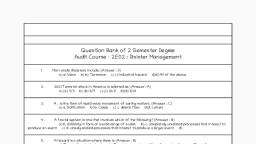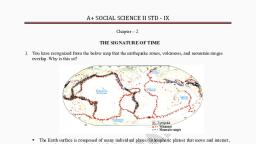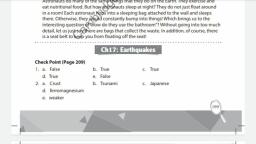Page 1 :
CHAPTER, , 4, , eo, ki, ng, do, m, , INTERNAL STRUCTURE OF THE EARTH, , Much of the informations what we know about the internal structure of the Earth, comes, from the;, 1. Geophysical techniques using Earthquake waves(VS , VP and seismic tomography), 2. Ophiolites, , 3. Mantle Xenoliths, 4. Meteorites, , G, , Earth’s internal structure is made up of layers of different compositions (both physically and, chemically), which are broadly grouped in three distict layers as follows;, 1. The Crust, 2. The Mantle, 3. The Core, , 4.1, , The Crust, , The outer most layer of the Earth and Bullen’s layer-A. Average depth of this layer is 33, km., 1
Page 2 :
Page 2, , Chapter 4, , 1. Continental Crust, The crust of the land part. Average depth over the continents is 35 km, maximum, depth over mountain rnges is 80 km., (a) Upper Continental Crsut, Extends from the surface to 11 km, with granitic-granodioritic composition, and, also known as sial., (b) Lower Continental Crust Extends from 11 to 35 km, also known as sima., i. Outer Sima(11-22 km, intermediate in composition), ii. Inner Sima(22-35 km, ultrabasic in composition), , eo, ki, ng, do, m, , Upper and lower continental crusts are separated by Conrad discontinuty at 11 km., 2. Oceanic crust, The crust of the ocean part. Average thickness is from 5 to 8 km, and minimum 0 km, at mid oceanic ridges. Sialic layer is absent., The average composition of the crust is andesitic., , 4.2, , The Mantle, 35-2890 km, , 83% by volume and 68% by mass of the Earth. Composition is pyrolite = 3 parts ultramafic, rock + 1 part basalt., , Upper Mantle, 35-410 km, Gutenberg Layer, , G, , 4.2.1, , Decrease in seismic velocity. Lithosphere(0-80 km) = Crust and the upper part of the upper, mantle. Lithosphere is underlain by Asthenosphere(80-220 km) characterised by decrease in, S-wave velocity. An abrupt increase of P- and S-wave velocities by 3–4% has been observed, at around 220 +-30 km depth; it is called the Lehmann discontinuity. Between the lid and, the Lehmann discontinuity(lower part of the asthenosphere), in the depth range 100–200 km,, body-wave velocity gradients are weakly negative, i.e., the velocities decrease with increasing, depth. This layer is called the low-velocity layer (LVL)., , 4.2.2, , Transition zone, 400-770 km, , Two transition zones are present at 400-670 km and 670-770 km., Geokingdom
Page 3 :
Chapter 4, , 4.2.3, , Page 3, , Lower Mantle, 770-2980 km, , Some of the second order discontinuities:, 1. Density break: At 80 km, 3.36 to 3.87 g/cc (lithosphere to asthenospheric transition)., 2. Gravity break: At 150 km, gravity decreases from 984 to 974 cm/sec2 ., 3. Gravity break: At 1200 km, gravity increases from 974 to 1068 cm/sec2 at the coremantle boundary., 4. Seismic discontinuity: At 410 km, there is a decrease in seismic velocity., , eo, ki, ng, do, m, , 5. Seismic discontinuity: At 2700 km, there is increase in seismic velocity to its maximum, at 3 km/sec., 6. Repeti discontinuty: At 950-1000 km, marked by increase in seismic velocity., 7. Bullen’s discontinuty: At 410 km, marked by increase in seismic velocity., According to Bullen’s layers,, , 1. Upper mantle(33-1000km):, , (a) Gutenberg layer(33-410 km), (b) Golistyn layer(410-1000 km), 2. Lower Mantle(1000-2900 km), , 4.3, , G, , (a) Upper part(1000-2700 km): P-wave velocity is maximum, 13.7 km/sec., (b) Lower part(2700-2900 km): P-wave velocity decreses to 12.6 km/sec., , The Core,Gutenberg-Weichert discontinuity, 28906370 km, , 17% by volume and 34% by mass of the Earth., 1. Outer Core Fluid state, S-wave velocity is zero and P-wave velocity decreases form, 12.6 to 8.4 km/sec from lowwer mantle to outer core., 2. Inner Core Solid state, S-wave and P-wave velocity increases, compsitionally sloid, Nickle and Iron(Nife). The core’s pressure is about 3 million atmospheric pressure and, temperature is about 6000 K. Density changes from 5.5 in mantle to 10.6 in the core,, to 13 g/cc at the centre of the Earth. Inner and Outer core are separated by Lehman, discontinuity., Geokingdom














































